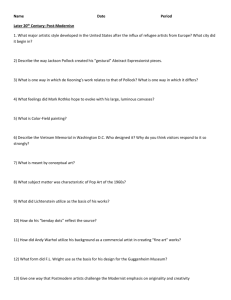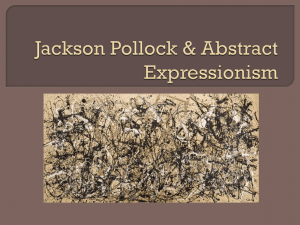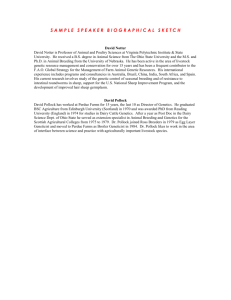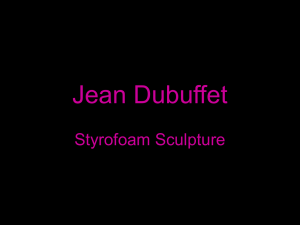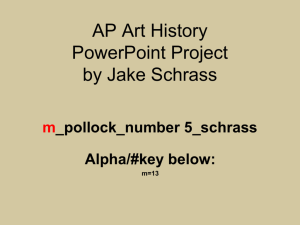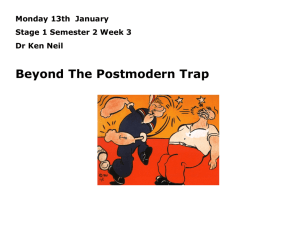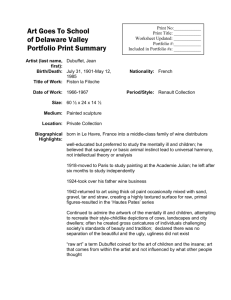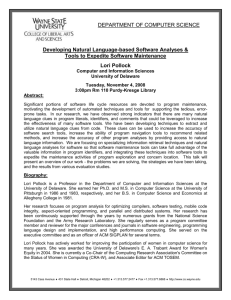Spring 2012 MIT 4.602, Modern Art and Mass Culture (HASS-D) Notes
advertisement
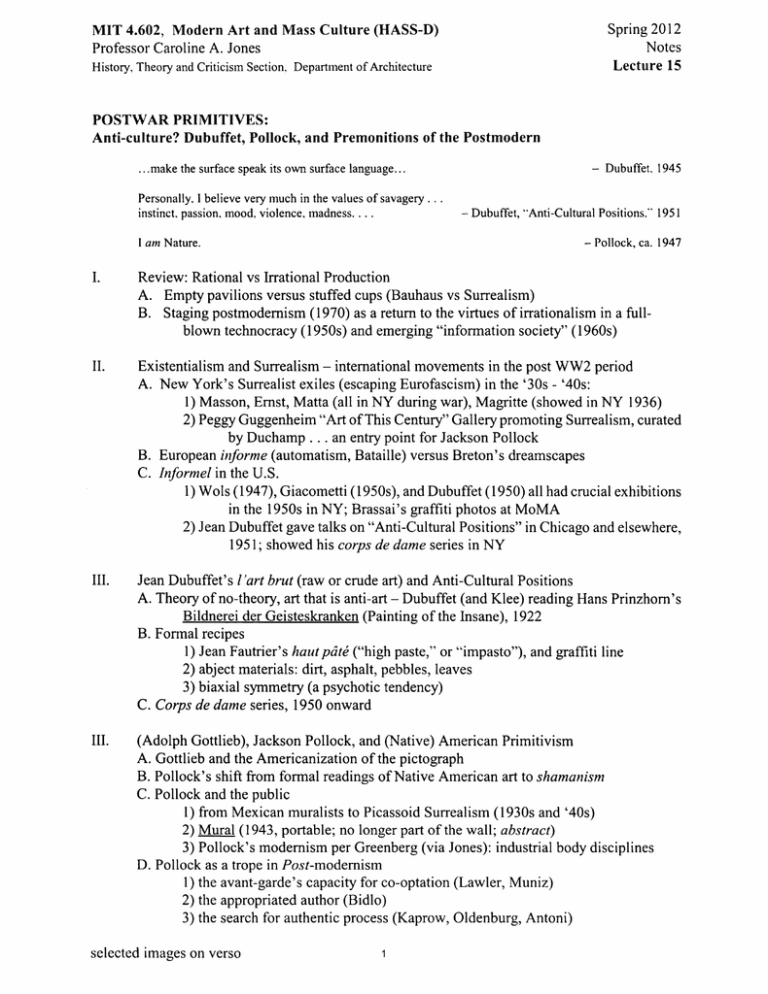
Spring 2012 Notes Lecture 15 MIT 4.602, Modern Art and Mass Culture (HASS-D) Professor Caroline A. Jones History, Theory and Criticism Section. Department of Architecture POSTWAR PRIMITIVES: Anti-culture? Dubuffet, Pollock, and Premonitions of the Postmodern ... make the surface speak its own surface language... Personally. I believe very much in the values of savagery ... instinct. passion, mood. violence. madness. . . . I am Nature. - Dubuffet. 1945 - Dubuffet, "Anti-Cultural Positions:' 1951 - Pollock, ca. 1947 I. Review: Rational vs Irrational Production A. Empty pavilions versus stuffed cups (Bauhaus vs Surrealism) B. Staging postmodernism (1970) as a return to the virtues of irrationalism in a fullblown technocracy (1950s) and emerging "information society" (1960s) II. Existentialism and Surrealism - international movements in the post WW2 period A. New York's Surrealist exiles (escaping Eurofascism) in the '30s - '40s: 1) Masson, Ernst, Matta (all in NY during war), Magritte (showed in NY 1936) 2) Peggy Guggenheim "Art of This Century" Gallery promoting Surrealism, curated by Duchamp ... an entry point for Jackson Pollock B. European informe (automatism, Bataille) versus Breton's dreamscapes C. Informel in the U.S. I) Wols (1947), Giacometti (1950s), and Dubuffet (1950) all had crucial exhibitions in the 1950s in NY; Brassai's graffiti photos at MoMA 2) Jean Dubuffet gave talks on "Anti-Cultural Positions" in Chicago and elsewhere, 1951; showed his corps de dame series in NY III. Jean Dubuffet's I 'art brut (raw or crude art) and Anti-Cultural Positions A. Theory of no-theory, art that is anti-art - Dubuffet (and Klee) reading Hans Prinzhorn's Bildnerei der Geisteskranken (Painting of the Insane), 1922 B. Formal recipes 1) Jean Fautrier's haut piite ("high paste," or "impasto"), and graffiti line 2) abject materials: dirt, asphalt, pebbles, leaves 3) biaxial symmetry (a psychotic tendency) C. Corps de dame series, 1950 onward III. (Adolph Gottlieb), Jackson Pollock, and (Native) American Primitivism A. Gottlieb and the Americanization of the pictograph B. Pollock's shift from formal readings of Native American art to shamanism C. Pollock and the public I) from Mexican muralists to Picassoid Surrealism (1930s and '40s) 2) Mural (1943, portable; no longer part of the wall; abstract) 3) Pollock's modernism per Greenberg (via Jones): industrial body disciplines D. Pollock as a trope in Post-modernism 1) the avant-garde's capacity for co-optation (Lawler, Muniz) 2) the appropriated author (Bidlo) 3) the search for authentic process (Kaprow, Oldenburg, Antoni) selected images on verso 1 Image List (selected) for Lecture 15 all works are olc unless noted~ Dubuffet's also often include gravel, sand, pebbles Bauhaus: Ludwig Mies van der Rohe, Barcelona Pavilion (and chair), International Exposition, Barcelona, Spain, 1928-29, architectural design and building, interior decorations, furnishings. Paul Klee, Magic Garden, 1926, mixed media (often he works with plaster and paint on paper on canvas) Surrealism: Alberto Giacometti, City Square (Plaza). 1948 Max Ernst Europe After the Rain, 1949-52 Yves Tanguy, Indefinite Divisibility, 1942 Andre Masson, Elk Attacked by Dogs, 1945 Rene Magritte, The Key of Dreams, 1936 Brassai (G. Halasz), Graffiti series, early 1930s photographs, published in a book and shown at MoMA in 1950s, fueling "infonnel" Parisian Illforme, or "Informel" Wols, (Wolfgang Schulze), Painting 1944-45 olc Wols, The Blue Phantom, 1951 olc Jean Fautrier,The Massacre (also known as Sarah), 1944 olpaper on canvas [ "haut pate"] Fautrier, Tete d'Otage, no. 8 (Head of Hostage, 8) "1943"0/cardboard with plaster [ "haut pate"] Jean Dubuffet, Metro, 1943 olc Dubuffet, The Smoker by a Wall, 1945, olc Dubuffet, Archetypes, 1945 olc Dubuffet, Fautrier from the Front, 1947 olc AdolfWolfli, Herdsman, 1911, drawing <- "Outsider" artist, clinically insane Dubuffet, Will to Power, 1946 Dubuffet, Tree of Fluids (corps de dame) 1950 olcAdolph Gottlieb, Pictograph, 1946 American-Type Painting (aka "Action Painting," "Abstract Expressionism") Pacific Northwest Native American works: Kwakiutl painted cedar bark cape, 191h century Tlingit speaking peoples, House Screen, 1840, carved, assembled, and painted wood Haida Mask, ca. 1850s George Walkus (Kwakiutl people), Dance Mask 1938, carved, assembled, and painted wood Gottlieb, Evil Omen, 1946 Jackson Pollock, Birth, 1938-41 Pollock, Bird, 1938-41 Pollock, Head, 1940-41 Pollock, She-Wolf, 1943 Pollock, Mural, 1943 Pollock, Totem Lesson #2, 1945 Pollock, No.1, 1948 (and detail with handprints) Hans Namuth, Pollock Painting, 1950, photographs; (and film with Paul Falkenberg, 1951) Gjon Mili, Picasso Painting with Light 1949, photograph published in Life magazine MilL Housewife Making a Bed, 1946 Ruptures in the Modernist Avant-Garde Cecil Beaton, "The New Spring Line," Vogue models in front of Pollock's Lavender Mist, 1951 Allan Kaprow, Yard, 1961 ("Happening," installation and participation) Claes Oldenburg, The Store, 1961-62 (ongoing "Happening") Nonnan Rockwell, The Connoisseur, 1962 Postmodern Pollocks Vik Muniz, Action Photo, after Hans Namuth from Pictures of Chocolate, 1997. (Photograph of chocolate painting of appropriated photograph) Louise Lawler, Pollock and Tureen Arranged by Mr and Mrs Burton Tremaine, Connecticut, 1984 Mike Bidlo, Not Pollock ("Pollock" series), 1982-84. Janine Antoni, Loving Care (perfonnance art), 1992. 2 MIT OpenCourseWare http://ocw.mit.edu 4.602 Modern Art and Mass Culture Spring 2012 For information about citing these materials or our Terms of Use, visit: http://ocw.mit.edu/terms.
